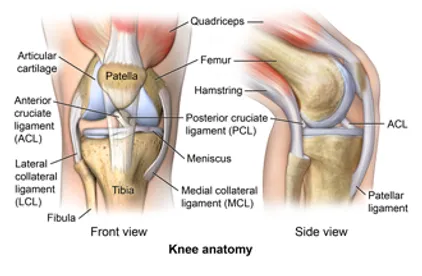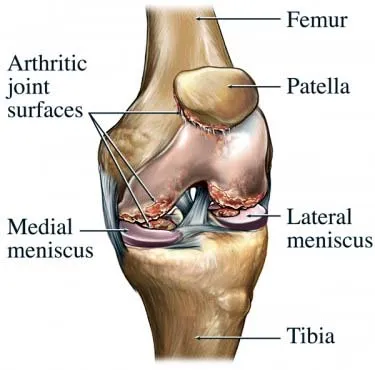Knee pain or injuries are very common and there are numerous issues that can cause this. Knee problems can be caused by soft tissue (ligaments, tendons, muscles), bone conditions (knee arthritis), biomechanical (running gait issues etc.) just to name a few… This is why it is important to receive a thorough assessment to ensure you receive the correct diagnosis and treatment for your knee pain.

The meniscus is a rubbery, C-shaped speciliased type of cartilage. It acts as a shock absorber for the knee and provides rotational stability. Each knee has 2 menisci – one on the inside and one on the outside of the knee.
A meniscal tear is commonly caused by a single acute injury, such as a quick twist or sudden turn. There are many different types of tears.
Latest research says that surgery should not be recommended as first choice of treatment but rather conservative treatment (Lee, Park, Kim, Nam , Park, Song & Kang, 2018).

Patellofemoral Pain syndrome is an umbrella term used to describe pain around the front of the knee and around the patella.
Causes include; overuse, patella malalignment, muscular weakness or imbalances and much more.
The most common symptom is a dull, aching pain in the front of the knee. Other symptoms include pain during exercise and activity, pain after sitting for a long time with your knee bent, popping or crackling sounds in your knee.
The knee is made up of multiple ligaments that are important for providing stability. Commonly known ligaments include; ACL (anterior cruciate ligament, PCL (posterior cruciate ligament) MCL (medial collateral ligament) and LCL (lateral collateral ligament).
Ligament Injuries are graded as ‘sprains’ and fall into catagories;
Grade 1 – mild damage, the tendon has been strecthed but able to stabilise the joint.
Grade 2/Partial Tear – tendon stretches until it becomes loose.
Grade 3/Full Tear – Ligament has been split in two, the joint is unstable

The most common types of arthritis that affect the knee is Osteoarthritis (OA) and Rheumatoid Arthritis (RA). In OA, the cartilage in the knee gets worn away and becomes rough. This can lead to the bone rubbing against each other and the formation of painful bony spurs.
With RA, the protective covering around the joint, known as the synovial membrane, becomes inflamed and painful. RA is symmetrical, meaning it usually affects the same joint(s) on both sides of the body.
Knee arthritis can generally be painful and quite debilitating and most commonly develops over time however sudden onset is possible too.

Lee DY, Park YJ, Kim HJ, Nam DC, Park JS, Song SY, Kang DG. Arthroscopic meniscal surgery versus conservative management in patients aged 40 years and older: a meta-analysis. Arch Orthop Trauma Surg. 2018 Dec;138(12):1731-1739.